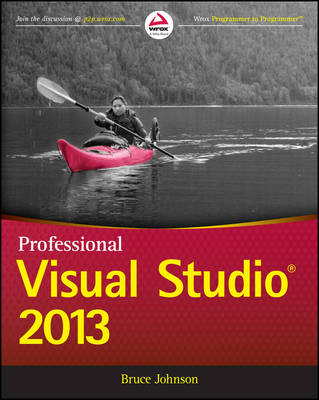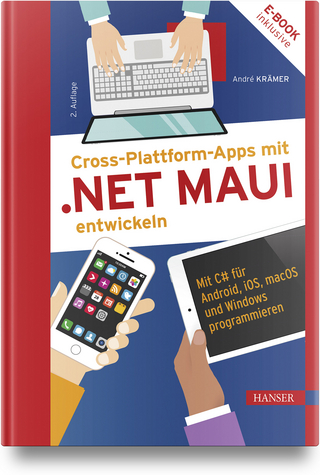
Professional Visual Studio 2013
Wrox Press (Verlag)
978-1-118-83204-2 (ISBN)
- Titel ist leider vergriffen;
keine Neuauflage - Artikel merken
Comprehensive guide to Visual Studio 2013 Visual Studio is your essential tool for Windows programming. Visual Studio 2013 features important updates to the user interface and to productivity. In Professional Visual Studio 2013, author, Microsoft Certified Trainer, and Microsoft Visual C# MVP Bruce Johnson brings three decades of industry experience to guide you through the update, and he doesn't just gloss over the basics. With his unique IDE-centric approach, he steers into the nooks and crannies to help you use Visual Studio 2013 to its maximum potential. * Choose from more theme options, check out the new icons, and make your settings portable * Step up your workflow with hover colors, auto brace completion, peek, and CodeLens * Code ASP.NET faster than ever with new shortcuts * Get acquainted with the new SharePoint 2013 environment * Find your way around the new XAML editor for Windows Store apps Visual Studio 2013 includes better support for advanced debugging techniques, vast improvements to the visual database tools, and new support for UI testing for Windows Store apps.
This update is the key to smoother, quicker programming, and Professional Visual Studio 2013 is your map to everything inside.
Bruce Johnson is a partner at ObjectSharp Consulting and a 30 veteran of the computer industry. For almost 20 years, he has been working on projects that are at the leading edge of Windows technology, from C++ through Visual Basic to C#, and from thick client applications to websites to services. Wrox Professional guides are planned and written by working programmers to meet the real-world needs of programmers, developers, and IT professionals. Focused and relevant, they address the issues technology professionals face every day. They provide examples, practical solutions, and expert education in new technologies, all designed to help programmers do a better job. www.wrox.com
Introduction xliii Part I: Integrated Development Environment Chapter 1: A Quick Tour 3 Getting Started 3 The Visual Studio IDE 7 Chapter 2: The Solution Explorer, Toolbox, and Properties 15 The Solution Explorer 15 The Toolbox 23 Properties 27 Chapter 3: Options and Customizations 33 The Start Page 33 Window Layout 34 The Editor Space 39 Other Options 43 Importing and Exporting Settings 47 Chapter 4: The Visual Studio Workspace 51 The Code Editor 51 Code Navigation 60 The Command Window 65 The Immediate Window 66 The Class View 67 The Error List 68 The Object Browser 68 The Code Definition Window 69 The Call Hierarchy Window 70 The Document Outline Tool Window 71 Reorganizing Tool Windows 73 Chapter 5: Find and Replace and Help 75 Quick Find/Replace 75 Find/Replace in Files 78 Accessing Help 82 Part II: Getting Started Chapter 6: Solutions, Projects, and Items 89 Solution Structure 89 Solution File Format 91 Solution Properties 92 Project Types 95 Project Files Format 97 Project Properties 97 Web Application Project Properties 112 Web Site Projects 115 Chapter 7: IntelliSense and Bookmarks 117 IntelliSense Explained 117 JavaScript IntelliSense 124 XAML IntelliSense 126 IntelliSense Options 127 Extended IntelliSense 129 Bookmarks and the Bookmark Window 130 Chapter 8: Code Snippets and Refactoring 133 Code Snippets Revealed 133 Accessing Refactoring Support 144 Refactoring Actions 144 Chapter 9: Server Explorer 151 Server Connections 151 Data Connections 164 SharePoint Connections 164 Summary 165 Chapter 10: Modeling with the Class Designer 167 Creating a Class Diagram 167 The Design Surface 168 The Toolbox 169 The Class Details 170 The Properties Window 171 Layout 172 Exporting Diagrams 172 Code Generation and Refactoring 173 Part III: Digging Deeper Chapter 11: Unit Testing 179 Your First Test Case 179 Asserting the Facts 188 Initializing and Cleaning Up 191 Testing Context 192 Advanced Unit Testing 195 Testing Code Contracts 197 Chapter 12: Documentation with XML Comments 201 Inline Commenting 201 XML Comments 202 Using XML Comments 215 Generating Documentation with GhostDoc 216 Compiling Documentation with Sandcastle 218 Task List Comments 220 Chapter 13: Code Consistency Tools 223 Source Control 223 Coding Standards 228 Chapter 14: Code Generation with T4 235 Creating a T4 Template 235 T4 Building Blocks 238 How T4 Works 242 T4 Directives 244 Troubleshooting 247 Generating Code Assets 248 Runtime Text Templates 252 Tips and Tricks 256 Summary 257 Chapter 15: Project and Item Templates 259 Creating Templates 259 Extending Templates 267 Starter Kits 274 Online Templates 275 Chapter 16: Language-Specific Features 277 Hitting a Nail with the Right Hammer 277 A Tale of Two Languages 280 Visual Basic 283 F# 284 Part IV: Rich Client Applications Chapter 17: Windows Forms Applications 293 Getting Started 293 The Windows Form 294 Form Design Preferences 296 Adding and Positioning Controls 298 Container Controls 303 Docking and Anchoring Controls 305 Summary 306 Chapter 18: Windows Presentation Foundation (WPF) 307 What Is WPF? 307 Getting Started with WPF 309 The WPF Designer and XAML Editor 315 Styling Your Application 326 Windows Forms Interoperability 327 Debugging with the WPF Visualizer 330 Chapter 19: Office Business Applications 333 Choosing an Office Project Type 333 Creating a Document-Level Customization 335 Creating an Application Add-in 340 Debugging Office Applications 345 Deploying Office Applications 347 Chapter 20: Windows Store Applications 349 What Is a Windows Store Application? 349 Creating a Windows Store Application 352 Part V: Web Applications Chapter 21: AS P.NET Web Forms 363 Web Application versus Web Site Projects 363 Creating Web Projects 364 Designing Web Forms 371 Web Controls 380 Master Pages 385 Rich Client-Side Development 387 Chapter 22: AS P.NET MV C 395 Model View Controller 396 Getting Started with ASP.NET MVC 396 Choosing a Model 398 Controllers and Action Methods 399 Rendering a UI with Views 402 Advanced MVC 409 Chapter 23: Silverlight 425 What Is Silverlight? 425 Getting Started with Silverlight 426 Navigation Framework 432 Theming 433 Enabling Running Out of Browser 435 Chapter 24: Dynamic Data 439 Creating a Dynamic Data Web Application 440 Customizing the Data Model 444 Customizing the Presentation 449 Enabling Dynamic Data for Existing Projects 460 Chapter 25: SharePoint 461 SharePoint Execution Models 461 Preparing the Development Environment 463 Exploring SharePoint 2013 464 Creating a SharePoint Project 466 Building Custom SharePoint Components 469 Working with Features 476 Packaging and Deployment 477 Chapter 26: Windows Azure 481 The Windows Azure Platform 482 SQL Azure 492 AppFabric 494 Azure Websites 494 Azure Virtual Machines 495 Part VI: Data Chapter 27: Visual Database Tools 499 Database Windows in Visual Studio 2013 499 Editing Data 506 Chapter 28: DataSets and DataBinding 507 DataSets Overview 507 Binding Data 512 Working with Data Sources 527 Summary 532 Chapter 29: Language Integrated Queries (LINQ) 533 LINQ Providers 533 Old-School Queries 534 Query Pieces 536 Debugging and Execution 540 LINQ to XML 541 Querying XML 544 Schema Support 545 LINQ to SQL 547 LINQPad 556 Chapter 30: The ADO .NET Entity Framework 559 What Is the Entity Framework? 560 Getting Started 561 Creating an Entity Model 561 Querying the Entity Model 573 Advanced Functionality 579 Chapter 31: Reporting 581 Getting Started with Reporting 581 Designing Reports 583 Rendering Reports 610 Deploying Reports 613 Chapter 32: Windows Communication Foundation (WCF) 617 What Is WCF? 617 Getting Started 618 Defining Contracts 619 Configuring WCF Service Endpoints 623 Hosting WCF Services 626 Consuming a WCF Service 631 Chapter 33: Windows Workflow Foundation (WF) 637 What Is Windows Workflow Foundation? 637 Why Use Windows Workflow? 638 Workflow Concepts 638 Getting Started 642 The Workflow Foundation Designer 644 Creating a Workflow 647 Hosting the Workflow Designer 654 Chapter 34: Client Application Services 659 Client Services 659 Role Authorization 662 User Authentication 664 Settings 666 Login Form 670 Offline Support 672 Chapter 35: Synchronization Services 677 Occasionally Connected Applications 677 Server Direct 678 Getting Started with Synchronization Services 681 Synchronization Services over N-Tiers 685 Chapter 36: WCF RIA Services 687 Getting Started 687 Domain Services 689 Domain Operations 692 Consuming a Domain Service in Silverlight 693 Part VIII: Confi guration and Resources Chapter 37: Configuration Files 701 .Config Files 701 Configuration Schema 703 Application Settings 708 User Settings 715 Referenced Projects with Settings 716 Chapter 38: Connection Strings 719 Connection String Wizard 719 SQL Server Format 723 In-Code Construction 724 Encrypting Connection Strings 726 LocalDB 727 Chapter 39: Resource Files 729 What Are Resources? 729 Resourcing Your Application 735 Satellite Resources 737 Accessing Specifics 739 Coding Resource Files 741 Custom Resources 742 Chapter 40: Using the Debugging Windows 749 The Code Window 749 The Breakpoints Window 750 The Output Window 751 The Immediate Window 752 The Watch Windows 753 The Code Execution Windows 755 The Memory Windows 757 IntelliTrace (Ultimate Edition Only) 759 The Parallel Debugging Windows 760 Exceptions 763 Chapter 41: Debugging with Breakpoints 767 Breakpoints 767 Tracepoints 773 Execution Control 774 Edit and Continue 776 Chapter 42: DataTips, Debug Proxies, and Visualizers 779 DataTips 779 Debugger Attributes 781 Type Proxies 784 Visualizers 786 Advanced Techniques 788 Summary 790 Chapter 43: Debugging Web App lic ations 791 Debugging Server-Side ASP.NET Code 791 Debugging Client-Side JavaScript 796 Tracing 800 Health Monitoring 803 Chapter 44: Advanced Debugging Techniques 807 Start Actions 807 Debugging with Code 809 Debugging Running Applications 811 .NET Framework Source 819 Multithreaded and Parallelized Application Debugging 821 Debugging SQL Server Stored Procedures 822 Mixed-Mode Debugging 823 Post-Mortem Debugging 823 Part X: Build and Deployment Chapter 45: Up grading with Visual Studio 2013 829 Upgrading from Visual Studio 2012 or 2010 829 Upgrading to .NET Framework 4.5.1 832 Chapter 46: Build Customization 835 General Build Options 835 Manual Dependencies 838 The Visual Basic Compile Page 838 C# Build Pages 843 MSBuild 844 Chapter 47: Assembly Versioning and Signing 851 Assembly Naming 851 Version Consistency 854 Strongly Named Assemblies 855 The Global Assembly Cache 856 Signing an Assembly 856 Chapter 48: O bfuscation, Application Monitoring, and Management 859 The MSIL Disassembler 859 Decompilers 861 Obfuscating Your Code 862 Application Monitoring and Management 870 Chapter 49: Packaging and Deployment 879 Windows Installer XML Toolset 880 ClickOnce 886 Chapter 50: Web Application Deployment 893 Web Deployment 893 Web Project Installers 896 The Web Platform Installer 897 Part XI: Customizing and Extending Vi sual Studio Chapter 51: The Automation Model 905 Visual Studio Extensibility Options 905 The Visual Studio Automation Model 906 Chapter 52: Add-Ins 913 Developing an Add-in 913 Deploying Add-ins 926 Chapter 53: Managed Extensibility Framework (ME F) 927 Getting Started with MEF 928 The Visual Studio Editor 934 Extending the Editor 935 Part XII: Vi sual Studio Ultimate Chapter 54: Visual Studio Ultimate for Architects 949 Modeling Projects 949 Exploring Code 956 Chapter 55: Visual Studio Ultimate for Developers 961 Code Metrics 961 Managed Code Analysis Tool 964 C/C++ Code Analysis Tool 965 Profiling Tools 965 Standalone Profiler 968 IntelliTrace 969 Database Tools 970 Chapter 56: Visual Studio Ultimate for Testers 977 Automated Tests 977 Relating Code and Tests 984 Visual Studio Test Management 986 Microsoft Test Manager 986 Chapter 57: Team Foundation Server 991 Team Project 992 Process Templates 992 Work Item Tracking 995 Excel and Project Integration 998 Version Control 1000 Team Foundation Build 1008 Reporting and Business Intelligence 1010 Team Portal 1011 Summary 1012 Index 1013
| Erscheint lt. Verlag | 8.4.2014 |
|---|---|
| Sprache | englisch |
| Maße | 186 x 234 mm |
| Gewicht | 1808 g |
| Themenwelt | Informatik ► Programmiersprachen / -werkzeuge ► NET Programmierung |
| Mathematik / Informatik ► Informatik ► Software Entwicklung | |
| ISBN-10 | 1-118-83204-3 / 1118832043 |
| ISBN-13 | 978-1-118-83204-2 / 9781118832042 |
| Zustand | Neuware |
| Haben Sie eine Frage zum Produkt? |
aus dem Bereich


